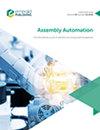Assembly line-Seru conversion in the C2M enterprise: an empirical study in China
IF 1.7
4区 计算机科学
Q3 AUTOMATION & CONTROL SYSTEMS
引用次数: 0
Abstract
Purpose To respond to customer needs and achieve customized manufacturing, the manufacturing industry, as represented by electronics assembly companies, has embarked on a path of business model transformation (customer to manufacturer [C2M]). The purpose of this paper is to examine the practical application of assembly line-Seru conversion in a Chinese electronics assembly company during the C2M transition. Design/methodology/approach To begin with, this paper proposed a production line improvement scheme suitable for the conversion of C2M manufacturing enterprise assembly line-Seru based on an analysis of the difficulties encountered in the existing production line of A company in China. Then, a mathematical model was presented for the minimum value of the makespan and the maximum workers’ expenditure between Serus. Finally, the SA-NSGA-II algorithm and the entropy-weight TOPSIS approach were used to determine the optimal scheme for Seru unit, batch, product type and worker distribution. Findings Seru production and multiskilled workers are more suited to the C2M business model. The most effective strategy for worker allocation can reduce the number of employees and makespan in Serus. Additionally, the performance of the SA-NSGA-II algorithm and the method of selecting the optimal solution from the Pareto solution by the entropy-weighted TOPSIS method is also demonstrated. Practical implications Through a detailed study of how to transform the production line, other companies can apply the methods outlined in this article to shorten the delivery time, make full use of the abilities of workers and assign workers to specific positions, thereby reducing the number of workers, workers’ expenditure and improving the balance rate of production lines. Originality/value Given the scarcity of studies on the production method of C2M-type firms in the prior literature, this paper examined the assembly line-Seru conversion problem with the goal of minimizing the makespan and worker expenditure. To address the NSGA-II algorithm’s insufficient convergence, the simulated annealing process is incorporated into the method, which improves the optimization performance.C2M企业装配线- seru转换:中国的实证研究
目的为了响应客户需求,实现定制化制造,以电子组装公司为代表的制造业走上了一条商业模式转型之路(客户到制造商[C2M])。本文的目的是检验组装线Seru转换在中国电子组装公司C2M转型期间的实际应用。设计/方法论/方法首先,本文在分析中国a公司现有生产线遇到的困难的基础上,提出了一种适合C2M制造企业装配线Seru改造的生产线改进方案。然后,给出了Serus之间完工时间最小值和工人支出最大值的数学模型。最后,使用SA-NSGA-II算法和熵权TOPSIS方法确定了Seru单元、批次、产品类型和工人分布的最优方案。FindingsSeru生产和多技能工人更适合C2M商业模式。在Serus,最有效的员工分配策略可以减少员工数量和工期。此外,还演示了SA-NSGA-II算法的性能以及通过熵加权TOPSIS方法从Pareto解中选择最优解的方法。实践意义通过对如何改造生产线的详细研究,其他公司可以采用本文所述的方法来缩短交货时间,充分利用工人的能力,将工人分配到特定的岗位,从而减少工人数量,减少工人支出,提高生产线的平衡率。原创性/价值鉴于现有文献中对C2M型企业生产方法的研究较少,本文以最小化制造周期和工人支出为目标,研究了装配线Seru转换问题。针对NSGA-II算法收敛性不足的问题,将模拟退火过程引入该方法,提高了算法的优化性能。
本文章由计算机程序翻译,如有差异,请以英文原文为准。
求助全文
约1分钟内获得全文
求助全文
来源期刊

Assembly Automation
工程技术-工程:制造
CiteScore
4.30
自引率
14.30%
发文量
51
审稿时长
3.3 months
期刊介绍:
Assembly Automation publishes peer reviewed research articles, technology reviews and specially commissioned case studies. Each issue includes high quality content covering all aspects of assembly technology and automation, and reflecting the most interesting and strategically important research and development activities from around the world. Because of this, readers can stay at the very forefront of industry developments.
All research articles undergo rigorous double-blind peer review, and the journal’s policy of not publishing work that has only been tested in simulation means that only the very best and most practical research articles are included. This ensures that the material that is published has real relevance and value for commercial manufacturing and research organizations.
 求助内容:
求助内容: 应助结果提醒方式:
应助结果提醒方式:


